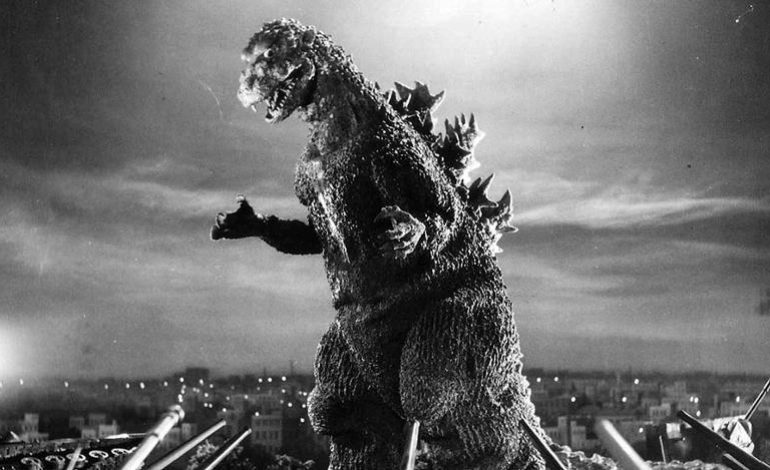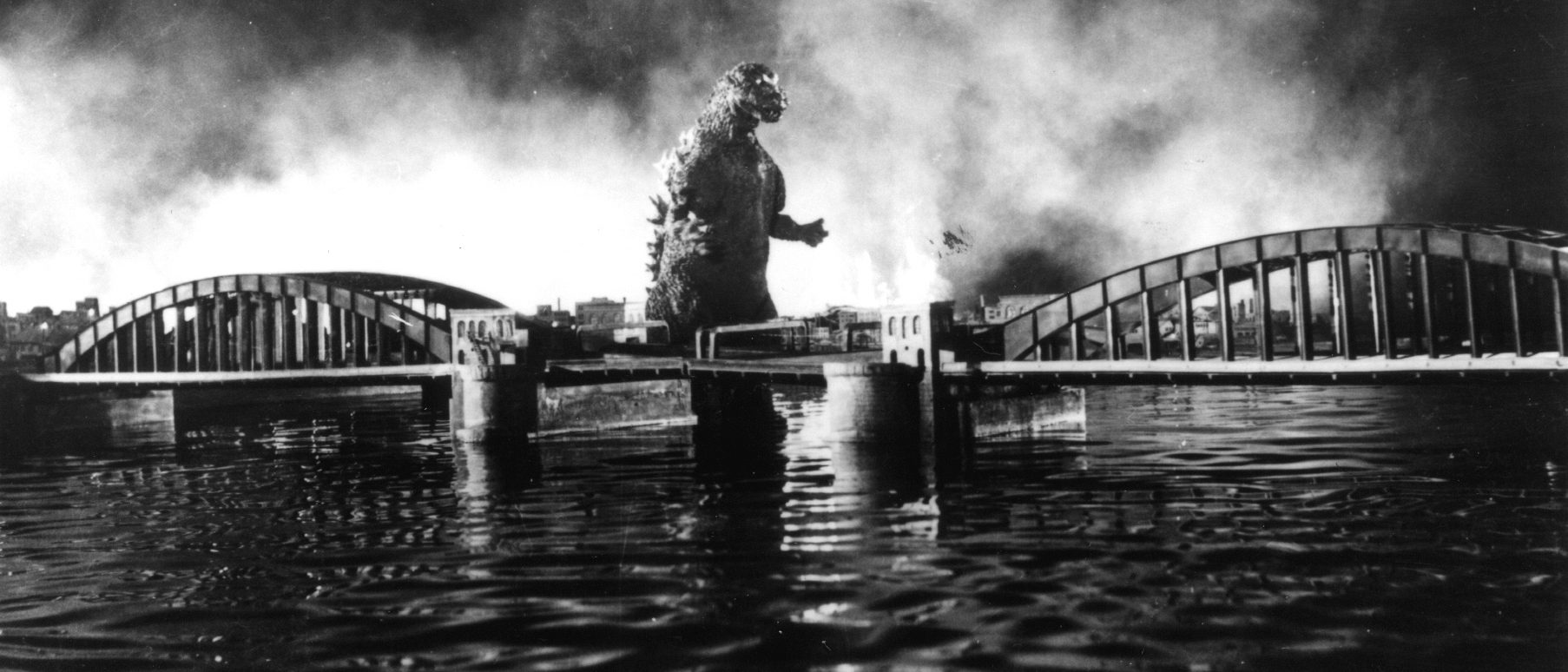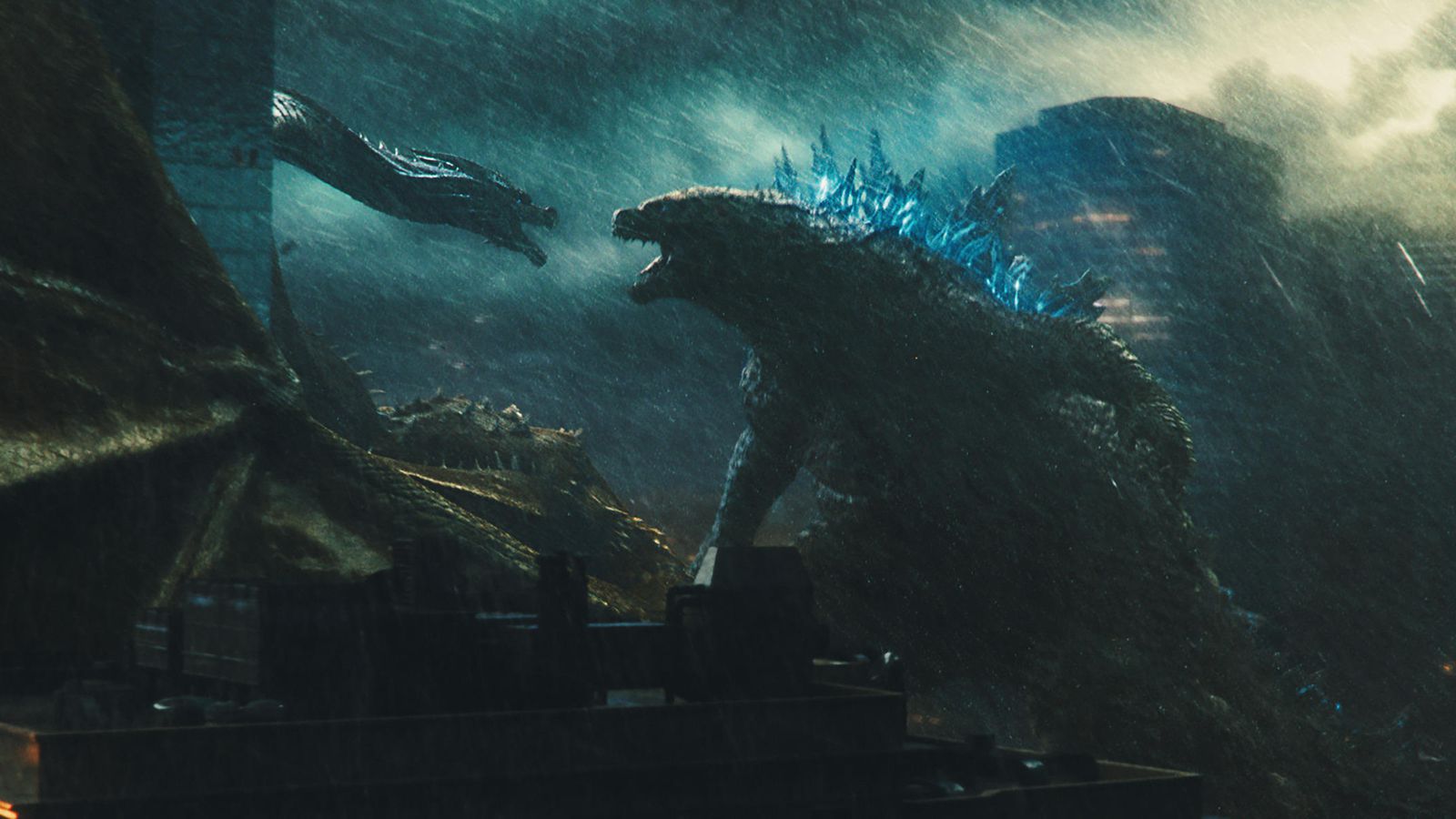

There are certain characters out there that grow beyond their own films, books, television shows, or what have you. The characters who ascend to the level of icon. Mickey Mouse, Superman, and Sherlock Holmes are just a few examples. Even if you’ve never seen or read a piece of media featuring one of these characters, you likely know them by appearance alone and know a lot of their general story. Godzilla is one such character that has reached this legendary status. Debuting in 1954, Godzilla has gone on to star in thirty-five movies, as well as countless television shows, video games, graphic novels, and every other form of media imaginable. Godzilla is a character whose inception was rooted in a very dark reality and would go on be everything from a superhero to a vengeful deity. Godzilla remains one of the most versatile characters in all of fiction.
Many know now that the original Godzilla was a bleak, anti-war film about the dangers of nuclear devastation. The atomic bombings of Hiroshima and Nagasaki most certainly were a strong influence on the creation of the original film, but not as many know about Lucky Dragon 5 incident. The Daigo Fukuryū Maru, or Lucky Dragon 5 was a Japanese fishing boat that was out on a routine voyage in March of 1954 when they were exposed to the radioactive fallout of the United States’ hydrogen bomb test at Bikini Atoll. With the atomic blast being larger than expected, the crew were exposed to radiation beyond the scope of the predicted safe zone. The crew suffered from radiation sickness and their haul of fish were contaminated as well, sparking headlines and fear back in Japan. Members of the fishing crew would face complications effects from the incident even decades later. This fear and anger would be channeled later that year in Toho Studios’ Godzilla (1954) directed by Ishiro Honda.
Godzilla begins with a fishing boat going about its business before being sunk in a blinding flash of atomic light. The film channels the anxiety of the Lucky Dragon as well as atomic bombings that only occurred nine years earlier. Honda, a former prisoner of war, gives his film a strong anti-nuclear and anti-war message. Godzilla is the story of the hellish ramifications that follow in the wake of testing nuclear weapons, told by a nation that knows better than any other just how deadly they are. Godzilla is killed at the end of the film, but it comes at the sacrifice of one of the story’s heroes, Dr. Serizawa. He uses a newly developed chemical weapon to kill the monster, and allows himself to die as well so that humanity not add another devastating weapon to its arsenal alongside the bomb. Godzilla is also a tragic figure. He’s scared and injured animal lashing out after being exposed to deadly fallout. His rough skin is designed to look like radiation burns. Godzilla is a victim too.


As the films ends, another character, Dr. Yamane, laments that as long as nuclear tests continue, another Godzilla will be born. Yamane’s comment certainly came true. Toho rushed a sequel out the following year after the movie’s financial success. They would develop several more Godzilla movies over the course of the 60s and 70s in what is known as the Shōwa period. In the first few films of this era, Godzilla is an antagonistic force who continually returns to wreak havoc upon Japan and battle other monsters. Monsters such as King Kong and Mothra fight against him and Godzilla retreats for the time being. The anti-nuclear message of the original film is certainly present in these movies, but they expand to focus on new perspectives and new themes. Godzilla Raids Again touches on the impact of the war and nuclear power on the home front. Mothra vs. Godzilla is about the destructive nature of corrupt corporate interest. King Kong vs. Godzilla is a critique of consumerism, even satirizing its own gimmicky premise and marketing.
It’s also fascinating to see how Godzilla himself evolves over the course of the Shōwa era. He’s a full on antagonist in the first few films but Ghidorah, The Three Headed Monster marks the beginning of a turning point. He teams up with fellow monsters Rodan and Mothra to protect the Earth from the alien menace King Ghidorah. The next few Shōwa films depict him as a begrudging defender of Earth, either fighting off aliens or a rogue terrorist organization bent on nuclear destruction as seen in Ebirah, Horror of the Deep. In Son of Godzilla we see a softer side of the monster as he takes on the role of adopted father to baby member of his species, Minya. At this point, the Godzilla franchise was hitting it big in Japan, especially with children. Many films began to feature child protagonists, with All Monsters Attack being the most experimental of these, telling the story of a latchkey kid who evades his problems by daydreaming about Monster Island and learning life lessons from Minya. It’s a cute children’s films about learning to stand up to bullies, but it also acts as a look at financial situation the country was facing at the time and how it negatively impacts families.
By the 1970s, Godzilla was a full on superhero, fighting off evil monsters like Hedorah, Gigan, and Mechagodzilla. The films of this decade seem like a far cry from Honda’s original grim piece, but these films still don’t lose sight of the original’s spirit. In Godzilla vs. Hedorah, the enemy is pollution incarnate. In Godzilla vs. Gigan the enemy is group of nefarious aliens who wish to colonize the planet under the pretense of spreading “peace”. Many of the monsters of this period are still awoken by rampant nuclear testing, but Godzilla not symbolizes a way to fight back against those byproducts. In a way, this slow shift in Godzilla’s character is a reclamation of the national trauma. Making something good out of destructive potential, just as nuclear power can be used as a more environmental friendly and efficient energy source.


In the 1980s and 90s, Toho would reboot the series for the new Heisei era. The 1984 film The Return of Godzilla takes Godzilla back to his roots as a destructive beast created by nuclear testing. This film also serves as fascinating time capsule of Cold War political relations. While Godzilla tears his way across Japan, the nation finds itself quite literally between the two big super powers of the world, the USA and USSR as the threat of a full on nuclear hangs above their heads. The Heisei era would reimagine several classic monsters like King Ghidorah, Mothra, and Mechagodzilla and update them for a more contemporary setting. Godzilla remains an anti-hero throughout, finding himself at odds with both humanity but also bigger threats to the planet as a whole. This series ends with Godzilla fighting against the evil Destoroyah, the byproduct of the chemical weapon used to kill the first Godzilla in 1954. These films were very successful in Japan, keeping Godzilla in the public conscious throughout the 80s and 90s.
The Godzilla series would continue in the early 2000s with the Millennium era. Perhaps the most interesting of this set is 2001’s Godzilla, Mothra and King Ghidorah: Giant Monsters All-Out Attack, where Godzilla is embodiment of the souls of all the civilians killed by the Japanese military during World War II. The spirits are angry that the people of Japan have forgotten the atrocities and war crimes that were committed and unleash the wrath of Godzilla upon the nation. He is fought back by Japan’s guardian monsters, but these creatures are explicitly defenders of the land, not its people. It makes for an incredibly compelling film.
Nowadays Godzilla is seeing something of a resurgence. In 2014, Legendary Pictures kick stared the MonsterVerse, an interconnected series of monster films in the same universe featuring the likes of Godzilla and Kong. In these films, Godzilla is an ancient defender of Earth who fights creatures awakened by nuclear power, as well as malicious alien threats. Conversely, 2016 saw the release of Shin Godzilla, a fresh new take from Toho Studios that drew inspiration from the 2011 Fukushima incident. The film is about the dangers of nuclear power, but also serves as a biting critique of how poorly the Japanese government handled everything in 2011. The MonsterVerse takes inspiration from the heroic Godzilla of the 1970s while Shin Godzilla is very closely in line with the original film’s spirit.


What’s important to know is that there is no right way to do a Godzilla movie. The first movie may have been a stark, anti-war film, but Godzilla is an incredibly versatile character. There’s a tendency among many film critics and film historians to dismiss any Godzilla film after the original. They get written off as cheesy and not worth talking about, but that ignores the very real messages of other films like Mothra vs. Godzilla and Godzilla vs. Hedorah. Even beyond the films that have serious real world connections, that doesn’t discredit the more lighthearted fair like Godzilla vs. Mechagodzilla. The Godzilla films aimed at children are still competently made and teach good lessons to their target audience. There’s room for the serious Godzilla and the light hearted. Right now we essentially have two vastly different Godzillas coexisting with the MonsterVerse and Shin Godzilla, and that’s ultimately the sign of a truly iconic and long standing character. There is no one right way.
There will always be Godzilla media out in the world. Even when the film go on hiatus there’s been new books or television shows or video games. As long as there are nuclear weapons there will be a Godzilla. As long as there is pollution there will be a Godzilla. As long as there is conflict at all, there will be a Godzilla. Whether he takes the form of a hero or villain, a destroyer or victim, there is always a story to be told, and that’s why Godzilla matters.
